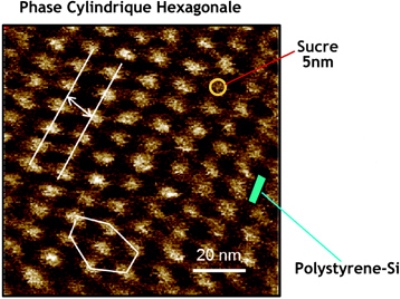A French-American alliance, which is led by the Centre de Recherchessur les Macromolécules Végétales (CNRS), has developed a new class of thin films using a combination of hybrid copolymers. These films can produce innovative applications in flexible electronics, such as photovoltaic cells, biosensors and nanolithography.
 The researchers have shown that this type of structure is capable of organizing itself into sugar cylinders within a petroleum-based polymer lattice, each structure having a size of 5 nanometers
The researchers have shown that this type of structure is capable of organizing itself into sugar cylinders within a petroleum-based polymer lattice, each structure having a size of 5 nanometers
The development opens up new possibilities for enhancing the speed of microprocessors and the capacity of hard discs.
Till date, the thin films that are utilized in electronic circuits have been fabricated using synthetic polymers, which are derived from petroleum. However, limitations exist in these films. They have minimum structural resolution of approximately20 nm, which cannot be decreased further by adding petroleum-derived polymers. This is one of the major obstacles for the development of next-generation of high-resolution flexible electronic devices. The limitation is due to the low incompatibility that occurs between the two polymers, derived from oil. Hence, to overcome the obstacle, CNRS team developed a new class of hybrid ultra-thin electronic films. These films combine petroleum-derived and sugar-based polymers with different chemical and physical characteristics.
The hybrid copolymer is comprised of more incompatible elementary building blocks and this structure has a capability to organize itself into sugar cylinders inside a petroleum-based polymer framework. Each structure has a size of 5 nm, which is considerably smaller than the structural resolution of earlier copolymers. Additionally, the new material is produced from sugar, a rich, biodegradable and renewable resource.
This outcome can lead to a wide range of applications in flexible electronics, including improved performance of photovoltaic cells; six-fold increase in information storage capacity; and miniaturization of circuit lithography. The team is now planning to enhance control of the large-scale organization of these nano-glycofilms, as well as design various self-organized structures.
Source: http://www.cnrs.fr/paris-michel-ange/?lang=fr